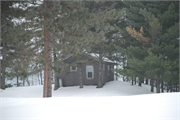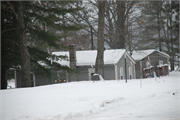Property Record
W5522 COUNTY TRUNK HIGHWAY F
Architecture and History Inventory
| Historic Name: | |
|---|---|
| Other Name: | |
| Contributing: | |
| Reference Number: | 159181 |
| Location (Address): | W5522 COUNTY TRUNK HIGHWAY F |
|---|---|
| County: | Washburn |
| City: | |
| Township/Village: | Brooklyn |
| Unincorporated Community: | |
| Town: | 41 |
| Range: | 12 |
| Direction: | W |
| Section: | 35 |
| Quarter Section: | |
| Quarter/Quarter Section: |
| Year Built: | 1951 |
|---|---|
| Additions: | |
| Survey Date: | 2011 |
| Historic Use: | house |
| Architectural Style: | Other Vernacular |
| Structural System: | Unknown |
| Wall Material: | Other |
| Architect: | |
| Other Buildings On Site: | |
| Demolished?: | No |
| Demolished Date: |
| National/State Register Listing Name: | Not listed |
|---|---|
| National Register Listing Date: | |
| State Register Listing Date: |
| Additional Information: | Previously surveyed in 2010. The property consists of six, circa 1951 vernacular cabins and a shed. 2012- "The property located at W5522 CTH F consists of six, circa 1951 cabins and a shed. A front gable and hipped roof cabin is located on the southwest corner of the property. The cabin is clad in asphalt roll siding, features exposed rafter tails and an exterior, concrete block chimney, is fenestrated with one-over-one, double-hung, wood sash windows, and has a wood deck on the west elevation. A side gable cabin is located immediately to the north. The cabin is clad with asphalt roll siding, features exposed rafter tails, is fenestrated with one-over-one, double-hung, wood sash windows, and has a small, wood deck on the south elevation. A third cabin is located to the north, along the northern edge of the property. The side gable cabin is clad in asphalt roll siding, features exposed rafter tails, and is fenestrated with six-over-one, double-hung, wood sash windows. A fourth cabin is located to the immediate northwest. The cabin has a side gable roof and is fenestrated with one-over-one windows. Other details were not discernable due to heavy vegetation. The fifth cabin is located on the northeast corner of the property. The one-story cabin rests upon a concrete block foundation, is clad in clapboard siding, and has a cross gable roof that is covered with asphalt shingles and features an exterior, fieldstone chimney. A side gable addition has been constructed on the east elevation. The cabin is fenestrated with two light, sliding, vinyl sash windows and sliding glass doors. A shed is located to the south. The front gable shed is clad in plywood and is fenestrated with a single-leaf, wood door on its west elevation. The sixth cabin is located south of the shed, along the east edge of the property. The front gable cabin is clad in asbestos siding, features exposed rafter tails, and is fenestrated with multi-light, wood sash windows. According to tax assessor records, this property was constructed in 1951. Buildings appear to exist on this property on a 1953 aerial photograph; however, due to dense vegetation and the poor quality of the photograph, it is unclear how many cabins were present at that time (Arrowhead Aerial Surveys 1953). Ownership information during that time was not available. However, by 1963 the property was under the ownership of Edwin Hlapcik (Rockford Map Publishers 1963). Mr. Hlapcik retained ownership of the property through at least 1977 (Rockford Map Publishers 1977). This cabin court was constructed in 1951 after the area around Silver Lake had become easily accessible by automobile. In 1905, a gravel road, known as CTH F, was built east-west through Lampson on the south side of Silver Lake (Wisconsin Historical Society 2010a). In 1917, STH 11, also a gravel road, was built west of Silver Lake and perpendicular to CTH F. In 1926-1927, USH 53 replaced STH 11 which connected La Crosse, Wisconsin via Eau Claire with Superior. In 1946, the final expanse of USH 53 was paved and vehicle traffic along the road increased (Bessert 2009). With its excellent highway connections, the Village of Lampson was able to capitalize on the growth of recreation-tourism across northwestern Wisconsin post World War II. The decline of the automobile camp in the late 1920s can be attributed to the rise of cabin and motor courts. Rental cabins began to become more popular and abundant after property owners realized that travelers were willing to pay for more permanent and private accommodations (Wisconsin Historical Society 201 Od). Cabin courts were often comprised of several small cabins arranged around a central courtyard space. The cabin courts were often designed around national and regional themes such as adobe huts, log cabins, and teepees (Wisconsin Historical Society 201 Od). This cabin court is associated with the recreation and tourism industry in northern Wisconsin during the post World War II era. The tourism industry in Wisconsin started to develop as early as the mid-nineteenth century; however it was largely seasonal, occurring during the summer season. With the advent of the automobile in the early twentieth century and the corresponding development of the state highway system the industry started to grow and spread; however, it was not until after World War II that the industry started to undergo a rapid expansion. This was attributed to an increase in affluence, automobile travel, and an improved highway system. These factors enabled many residents of Wisconsin as well as the Twin Cities and Chicago to take northern excursions to lake areas throughout Wisconsin (Wisconsin Historical Society 2010d)." -"CTH F, STH 77 and CTH T- all at US 53", WisDOT 1195-01-00, Prepared by the 106 Group (2010). The tourism industry in Wisconsin was developed as early as the mid-nineteenth century although it really was not until after World War II that the industry underwent rapid expansion. This was attributed to an increase in affluence, automobile travel, and an improved highway system. These factors enabled many residents of Wisconsin as well as the Twin Cities and Chicago to take northern excursions to lake areas throughout Wisconsin. Resorts, cabins, hotels, motels, campgrounds, and associated businesses such as restaurants, gas stations, and amusement parks increased throughout the state. Prior to World War II, tourist accommodations largely consisted of campgrounds and cabin courts- a grouping of small, private cabins or cottages around a central, shared space, often a courtyard. After World War II, the roadside motel became the popular trend because they were less expensive to construct and maintain. Some former cabin courts were even adjoined and converted into motels. At first, the tourism-recreation industry was largely seasonal, occurring during the summer season. By the 1960s however, tourism had expanded to a year-round industry (Nesbit and Thompson 1989). The cabin court was constructed in 1951 after the area around Silver Lake had become easily accessible by automobile. |
|---|---|
| Bibliographic References: | Nesbit, Robert C. and William F. Thompson 1989 Wisconsin: A History, Volume 2. The University of Wisconsin Press, Madison, Wisconsin. Architecture and History Survey. May 2011. Prepared by Rachel E. Bankowitz. |
| Wisconsin Architecture and History Inventory, State Historic Preservation Office, Wisconsin Historical Society, Madison, Wisconsin |


